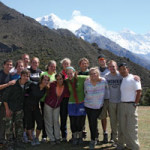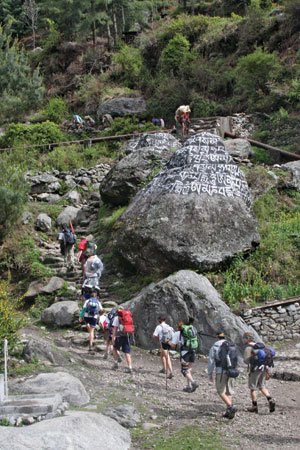
The longest day of trekking started with plenty of chai and ended in the village of Namche.
A little student muscle and the massive efforts of a Nepalese community aim to make commerce exchange cheaper and easier by shortening the distance between two points.
This past spring, David Pesek ’09, MS ’11 and Nepal native Lhakpa Sherpa led a group of 13 Mines students to the Himalayas to help support construction of a trail that could help revitalize the economies of several mountain villages.
It’s the same route used in 1953 by Sir Edmund Hillary and Nepalese Sherpa Tenzing Norgay on their way to summiting Everest for the first time, but over the last several decades it has fallen into disuse. As a consequence, the small mountain communities it connects have seen their economies shrink at a time when food prices have steadily climbed, prompting many to move to areas closer to the main trails.
David Pesek, a former Mines quarterback, played the lead role in organizing the 17-day trip. He’d been inspired by a trip to Afghanistan in 2007, where he’d worked alongside a group of volunteers and Afghan refugees on the construction of a community center. Wanting others to have similar opportunities, he cofounded a ?nonprofit organization called the Invictus Initiative, aimed at supporting disadvantaged communities around the globe by encouraging volunteerism, particularly among the technically skilled.
The Nepal trip was the first he’d organized on this scale, the idea arising from a conversation he had with Lhakpa Sherpa, owner of the Sherpa House restaurant in Golden. Lhakpa has an intimate knowledge of the geography of the area, having grown up in Sengma, one of the tiny villages along the historic trail.
He’s been working for several years to gather support for rebuilding the trail and explains how the route offers a much shorter journey from the busy Khumbu region to Traksindo, and thence to Jiri, the nearest town accessible by truck. Currently, most of the goods imported into the region are flown into the airport at Lukla, a treacherously short airstrip perched at 9,300 feet where only relatively small planes can land. The rest come up the valley via yak and mule trains. A trail that is a full day shorter than the existing alternative route is sure to siphon off some commerce, he reasons.
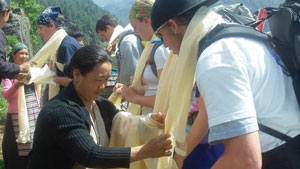
Prior to leaving Sengma on their way to camp outside Tate, the students were given white and gold scarves, representing a safe journey and a promise to return, in a traditional parting ceremony.
Any increase in traffic would benefit the economy of Sengma and its neighboring village, Tate. Lhakpa believes it could also help lower the cost of food in the whole region. In addition, it will provide alternative access to the high valleys, which in the past were cut off after ice dams in the glacier-strewn mountains above were breached, releasing entire lakes that washed away bridges downstream in catastrophic floods.
However, the historic trail through Sengma passes over some ridges that are too exposed for year-round travel, so these sections must be rerouted to a lower elevation and widened, if trains of yaks and pack mules are to pass safely. Several sections pass along a sheer cliff face.
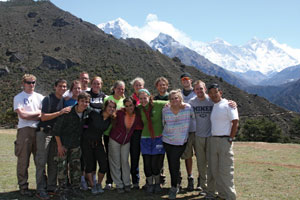
“It’s pretty wild,” says Pesek. “In places, the trail was about 6 inches wide, with a 500- to 1,000-foot drop.” Blasting into the cliff to carve out a wider ledge would be the best option, but that would require too many permits and too much paperwork, says Pesek, who predicts sections of suspended walkway are more likely to be built in the short term. In addition to these obstacles, two bridges need to be rebuilt.
Attracting tourist traffic isn’t the primary goal, but if the trail is wide and safe, it will attract some. Bad weather frequently strands tourists at Lukla airport, forcing some to pay dearly for a helicopter ride to avoid missing flights from Katmandu. A more predictable itinerary that includes a hike through the foothills to a bus in Jiri will appeal to some travelers; avoiding a flight into or out of one of the most dangerous airports in the world will win others; and a more dramatic and shorter approach to the Khumbu region by foot will lure still more. Presently, the minority of travelers who hike into the region pass along the valley floor; the shorter approach through Sengma remains higher and commands spectacular vistas of Everest and the surrounding mountains.
Connecting cultures
The Mines students who signed up for the hike were all asked to raise $3,400 for the trip, and the group collected an additional $2,000 to help fund trail construction. With flight time, getting to and from the area, and seeing a little of the Khumbu region, the team spent just three days working on the trail, but Pesek says they made good progress, and he sees the payoff in larger terms. “It was our intention to encourage the local community and work alongside them,” he says, “but more importantly, build relationships and show students, this is what Nepal is like, this is what the Sherpa community is like.”
The culture certainly made a deep impression on Hannah Schuster, a cross-country runner. “I never saw anyone in a hurry to be anywhere,” she says. “Even Sherpa porters carrying twice their body weight up a mountain had enough time to share a friendly ‘Namaste!'” After settling into a Himalayan mindset, she says she experienced ‘reverse culture shock’ upon her return to the fast pace of the United States. “I dearly miss the peace and quiet of the mountains,” she reflects.
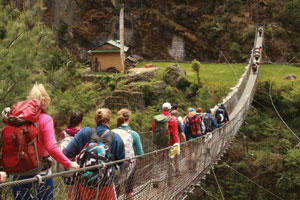
Suspension bridges comprised portions of the journey, here on the way to Sengma.
Footballer Brandon Oswald found himself a little outside his comfort zone at the beginning of the trip. “It was definitely a shock at first to see how the people lived,” he says, but the cultural differences were later dissolved by the friendliness of the Sherpa people. “The people were so welcoming to us, everyone spoke some English, so that helped as well,” he adds. “The trip was such an incredible experience.”
In his blog entry describing the students, first night in Sengma, Pesek writes about a meal in a traditional Sherpa House that the community prepared for their arrival. His description of the ceremonies that followed hint at an interesting cultural exchange:
The night concluded with a wonderful welcoming celebration where the local villagers of the area showed their appreciation and enthusiasm for the team with Sherpa singing, dancing and general celebratory fun. The welcoming was well received and the team responded with singing and dancing of our own an amazing night indeed.
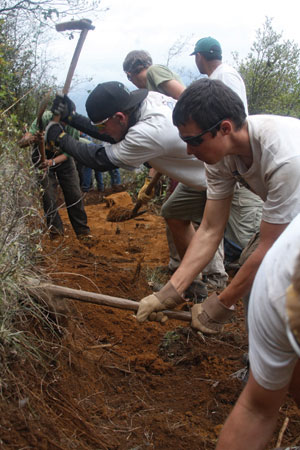
Mines students and Nepalese worked side-by-side clearing the trail.
In addition to their work on the trail, the students’ enthusiasm contributed a great deal, says Lhakpa. Their trip may have also helped encourage donations from the Nepalese community, from both the U.S. and the locals in Nepal. “Lhakpa has collected a little more than $23,000 for the project from the local community, and work is ahead of schedule and completing more trail per dollar than anticipated,” he says. Part of this is attributable to the cost of labor, trail workers earn about $5 per day, but he says it’s also more than simple economics. “People are willing to work hard for this trail,” he says, “because it’s something they need.”
Kimberly Mazza, a Harvey Scholar, whose trip was sponsored by the enrichment funds provided as part of her scholarship, gained an appreciation for the significance of the path they were building. “After hiking around to the different villages, I realized the importance of good trails in Nepal,” she says. “The location and quality of the trail we started will be a huge help to these villages.”
While their work was a meaningful contribution to the project, several students said they feel the Sherpa community gave them far more than they left behind. Schuster was one: “The lessons I have learned from this trip far exceed any help I could possibly give,” she says.
Learn more about the Invictus Initiative and Lhakpas initiative, Hike for Help. Lhakpa is organizing a second trip to Nepal in December and still has some space.

